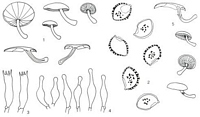|
 Gymnopilus mesosporus Gymnopilus mesosporus
BiostatusPresent in region - Indigenous. Endemic
Images (click to enlarge)
Caption: (PDD 27253, type; New Zealand):1. basidiomes. - 2. spores. - 3. basidia. - 4. cheilocystidia.
(ZT 69/61 (New Zealand):5: basidiomes. |
Article: Horak, E. (1989). New and additional data concerning Pyrrhoglossum and eccentric or laterally stipitate taxa of Gymnopilus (Agaricales). Opera Botanica 100: 115-129.
Description: Pileus -25 mm, convex to expanded, centre subdepressed in mature specimens, orbicular or subreniform in outline, non-striate margin inrolled; yellow-brown turning liver brown or chestnut brown with age; dry, conspicuously velvety or minutely squamulose, neither hygrophanous nor striate; veil remnants absent. Lamellae (14-24, -7), crowded; emarginate to subdecurrent with short tooth; brilliant golden yellow, changing to red-brown upon bruising or with brown spots in old basidiomes; concolorous edge even or subfimbriate. Stipe -20 x -2.5 mm. eccentric to sublateral, never central, always well developed, curved, equally cylindrical or swollen at base; concolorous with pileus or paler, below subpersistent cortina covered with yellow to whitish fibrils of veil; dry, fibrillose, at first solid becoming fistulose, rhizoids none, single or in clusters. Context yellow-brown turning reddish brown upon exposure. Odour not distinctive. Taste bitter.
Spores 7-8.5 x 5-6 µm, pip-shaped, plage and supraapicular depression distinctive, covered with very coarse isolated warts embedded in pale brown conspicuous perisporium, membrane rust brown (in KOH), germ pore absent. Basidia 23-30 x 6-7 µm, 4-spored, cylindrical to suburniform. Cheilocystidia 15-30 x 3-7 µm, fusoid with ± capitate apex, hyaline or filled with conspicuous yellow-brown sap. Pleurocystidia absent. -Pileipellis a trichoderm composed of cylindrical hyphae (4-10 µm diam.), membranes strongly encrusted with brown to red-brown pigment readily dissolving in KOH, terminal cells apically rounded, not differentiated, membranes not gelatinised. Clamp connections on all septa.
Habitat: On rotten log of coniferous (Podocarpaceae) or broadleaved trees (Violaceae).
Distribution: New Zealand.
Notes: According to my original field notes the first collection of this rather striking New Zealand agaric has been tentatively identified as "? Pyrrhoglossum sp." Subsequent microscopical analysis, however, left no doubt about its actual systematical position in Gymnopilus. Undoubtedly the most conspicuous microscopical character of G. mesosporus are its comparatively large and coarsely warted spores with an unusually well developed plage delimited by a thick perisporium. Hence this taxon with close relationships both to G. panelloides and G. macrosporus is a typical representative of sect. Gymnopilus (Hester 1969).
Among the European species of Gymnopilus there is only G. fulgens (Favre & Maire 1937) that has spores and cheilocystidia similar in size and structure as reported for the three above mentioned taxa. Despite its different macromorphology (stipe constantly central) and its unique habitat on peat and rotting Sphagnum in bogs this rarely encountered species (Kuhner 1947; Favre 1948) nevertheless must be considered to have close systematical relationships with G. mesosporus and its two other satellites with eccentric stipe described from the Far East or South America.
|